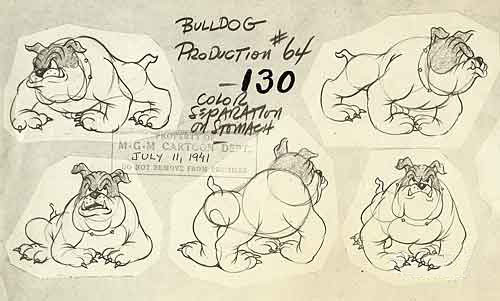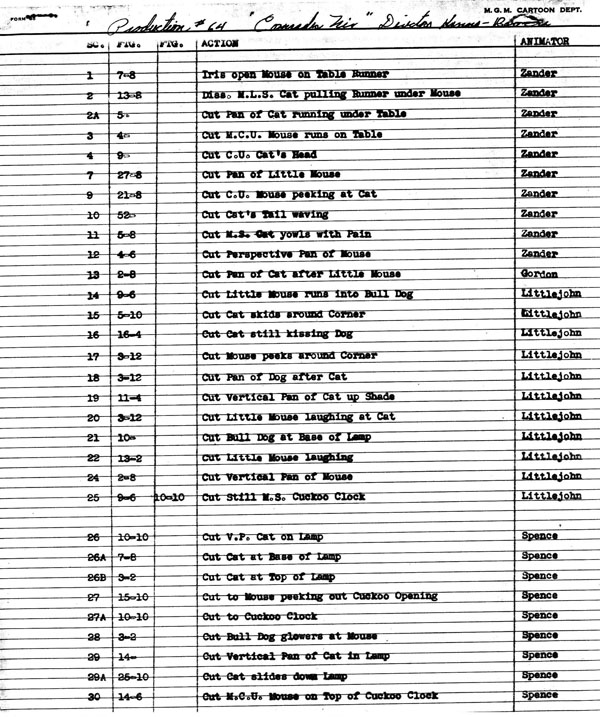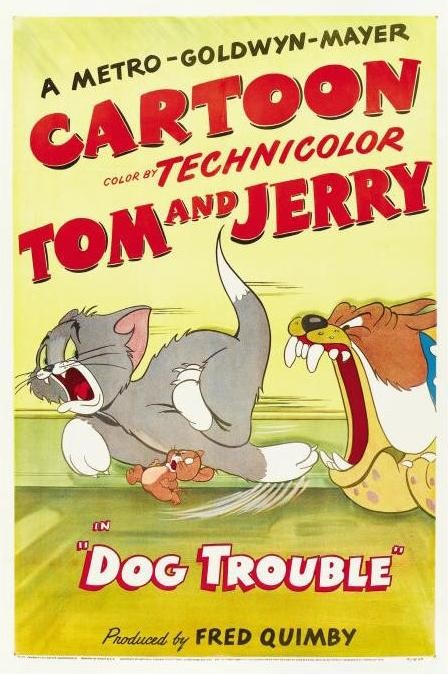
This week, we’re looking at an early Tom and Jerry that introduces a new bulldog opponent.
Bill Hanna and Joe Barbera knew how to differentiate their two stars from the “cat-and-mouse” archetype so common in animated cartoons. The fifth entry in the series, Dog Trouble (1942) – with the working title Comrades Mix — imbalances the equilibrium that fueled their chases, and has Tom and Jerry form a pact to dispatch an adversary. In this case, it’s Spike the Bulldog, with a design cribbed from Hugh Harman’s The Alley Cat, released a year earlier. The status of the Tom and Jerry relationship was still blooming in the hands of their creators; therefore, the ending of the cartoon dissolves their friendship and reverts to the status quo.
The previously analyzed Lonesome Mouse diverted from the standard approach as well, though only to help Tom’s inclusion back into the house. Their bond is broken in the end, since Tom isn’t so cordial to share his “re-ward” with Jerry. Later entries that united the two to eradicate different rivals, such as Old Rockin’ Chair Tom – where Jerry fittingly receives proper credit – and Triplet Trouble, strengthened their association. This first attempt is routinely paced, but Dog Trouble displays a smattering of sharp timing, specifically with Irv Spence’s sequences. Scene 29A showcases the swift action that intensifies this cartoon, and some great dry-brush work from the unsung ink-and-paint department.

Animator Cecil Surry spent his youth in Washington State. His family moved to San Diego in 1922. Surry enrolled in the Otis Art Institute and was recognized for his artistic talents by his second year. He won a poster competition sponsored by the Junior League of Los Angeles for Flintridge Riding Club’s third annual horse show.
He started at Disney’s in March 1930, but there are no records of the date of his departure. He moved over to Lantz around 1933 until Tex Avery recruited him to Schlesinger’s two years later, as part of the original “Termite Terrace” unit. By 1938, Surry migrated to MGM, drawing model sheets for Captain and the Kids (see example at left) and working on the early T&J entries, though it’s unclear how long he stayed. He served as an animator on Hugh Harman’s Johnny Learns His Manners (1946), and moved over to UPA in the early ‘50s. He made a brief return to Lantz, where he’s credited on three ’52-’53 titles (The Dog That Cried Wolf, The Mouse and the Lion, and The Flying Turtle). He returned to UPA and stayed until his 1956 death. Surry was also an artist/letterer at Dell Comics, drawing several Tom and Jerry and Mister Magoo stories.Bill Littlejohn, who passed away in 2010, was a benevolent figure in animation. He became the Screen Cartoonists Guild’s first president in 1938 and led the union during the 1941 Disney strike, which built the current institution for the industry. Littlejohn also co-founded ASIFA-Hollywood to preserve and promote the animated medium as an important art form.
 His aunt was a cameraperson at the Van Beuren Studios in New York, where he started as a cel washer. He eventually progressed from in-betweener to animator. When the studio closed, Littlejohn moved to Los Angeles and completed a degree in aeronautical engineering. He went to MGM around 1937, where, in one instance, he proved to skeptical animators that Milt Gross’ humor was fit for animation when he handled a test scene of J.R. the Wonder Dog.
His aunt was a cameraperson at the Van Beuren Studios in New York, where he started as a cel washer. He eventually progressed from in-betweener to animator. When the studio closed, Littlejohn moved to Los Angeles and completed a degree in aeronautical engineering. He went to MGM around 1937, where, in one instance, he proved to skeptical animators that Milt Gross’ humor was fit for animation when he handled a test scene of J.R. the Wonder Dog.
Littlejohn is more renowned for his work in several commercial studios, including animating the opening for Jay Ward’s Dudley Do-Right. He worked on commercials for Bill Melendez but also animated on several of the Peanuts television specials. He spent more than thirty years of his career, animating for John and Faith Hubley.
The draft for Dog Trouble dictates a July 29, 1941 production date, with a return on September 4 to create an additional four feet of footage, before the cartoon’s official April 18, 1942 release. It’s strange that scene 13, credited to George Gordon, is not present in the finished cartoon. It’s not too strange, considering it is only a superfluous two-foot pan shot of Tom chasing after Jerry. What’s more perplexing are the different scene numbers missing on the first page of the document. Were these omitted in production? Also note: the original release of this cartoon promoted defense bonds and stamps in the end credits – naturally this was cut for the June 21st, 1952 re-issue.
Hope you all enjoy this week’s breakdown video!




Poster for the cartoon’s reissue on June 21, 1952.
(Thanks to Mark Kausler and Dave Smith for their help.)



 DEVON BAXTER is a film restoration artist, video editor, and animation researcher/writer currently residing in Pennsylvania. He also hosts a
DEVON BAXTER is a film restoration artist, video editor, and animation researcher/writer currently residing in Pennsylvania. He also hosts a 





















































































Devon-
For which cartoon was the model sheet of the pirate from?
The Cockney pirate John Silver was in 5 of the MGM “Captain and the Kids” cartoons:
“Buried Treasure”
“The Winning Ticket”
“The Honduras Hurricane”
“Seal Skinners”
“The Captain’s Christmas”
I’d never heard of Hugh Harman’s “JOHNNY LEARNS HIS MANNERS” from 1946; was this a project that was later scrapped? Also, do prints of “DOG TROUBLE” actually exist with the “buy bonds” end credit?
“Johnny Learns His Manners” was an educational film done in, what we would call today, “Animatic” style – pencil drawings in black and white with minimal animation (like the “Baby Weems” sequence in The Reluctant Dragon). Here is an embed below.
In the scenes (by Gordon) of Tom shaking Jerry’s hand, notice he has only two fingers and a thumb! Usually the animators would draw Tom’s hands/front feet as having three digits (toes) when he’s on all-fours and four digits (fingers/thumb) when he’s upright, but this is an exception. He has the same two-fingers-and-thumb hands in a Muse scene from “Sufferin’ Cats”.
The animation in scene 19, by Bill Littlejohn, of the bulldog chasing Tom up the lamp-post was re-used at the end of “Puttin’ On The Dog.” In scene 16 Tom jumps between poses in an unusual way.
Given both cartoons came very early in the development of these characters, I could understand why that could be the case if they weren’t going too anthro on these guys just yet, (or at least go with the standard we’d see later in the series).
For what it’s worth. here’s Tom (by Zander) from this cartoon running in an endless cycle.
http://tralfaz.blogspot.com/2015/04/i-chase-meeces-to-pieces.html
Oh, if there were only information kept about layout and background people on this.
Hi Devon,
That model sheet of John Silver from The Captain and the Kids series was drawn by “Cartoon” Charlie Thorson, not Cecil Surry. The reason Surry put his name on the sheet was to mark it as his property at the studio, not to claim credit for drawing it.
Thanks for letting me know, Mark!
YOU SHALL DO POPEYE THE SAILOR MEETS SINBAD THE SAILOR NEXT